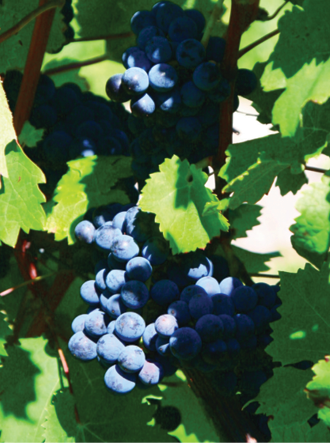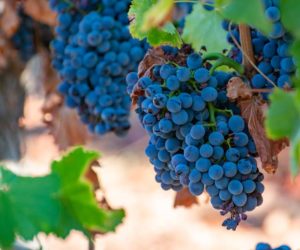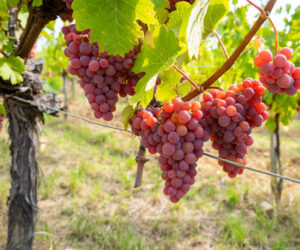
Bordeaux, France is the place where the six main noble red grapes come together in blends dominated by Merlot or Cabernet Sauvignon. The minor components of Cabernet Franc, Malbec, Petit Verdot and Carménère round out the blends depending on what type of season it has been. There has been considerable discussion about what years are best, and how the composition of the blend works out in any given year for any given château, but Cabernet Franc, one of the minor components in Bordeaux blends, actually enjoys the full spectrum spotlight elsewhere in France, notably, the Loire Valley. Cabernet Franc is the king red grape in this region and is as famous as the castles that dot the valley. The red wines of the Loire are not well known outside the region, and that is a secret that needs to be told. The Loire has a centuries-old tradition of winemaking and the generations of winemakers here understand how to maximize the full potential of the grape in a way that very few elsewhere in the world are able to do.
My wife and I visited the Loire Valley in 2011. It was our first trip to the region and I had no idea what to expect. We met up with a friend of a friend, not really knowing what we were getting into. On the train to Anjou, my wife asked me about this friend and I did not have any other information for her other than what he wrote in the email: that we would be staying at his house and he would arrange for some winery visits.
He greeted us at the train station in Anjou, recognizing me from a picture of me he saw on the Internet, and that was the beginning of three fantastic days of touring and tasting in the Loire Valley. What was not known to me was that our new friend, Charles, was one of the local consulting winemakers, and he had many clients he needed to visit in the three days we were there. In those three days, we experienced the region with respect to winemaking and tradition. The same varieties have been grown here for centuries on the same plots, owned by the same families, or by newcomers that were welcomed to do the same. It is a largely rural region with a lot of respect for your neighbors and friends, as well as as we found out, as I’ll explain later in this column, for “friends of friends.”
Cabernet Franc is thought to have originated in Southwest France, specifically in Libournais. This region is also known as the “Right Bank” of Bordeaux, and is home to several well-known and established appellations like Saint-Émilion, Pomerol and Fronsac. In this region Cabernet Franc is also known as Bouchet and blended with Merlot, which is also predominantly grown on the Right Bank. The clay, sand and limestone soils of the Right Bank are more suited for Merlot and Bouchet, in contrast to the Left Bank soils that are more gravelly where Cabernet Sauvignon is more suited. Sometime in the 17th century, plantings of Bouchet were introduced to the Loire valley to the northeast, in central France. The main areas where Cabernet Franc is grown and produced are Chinon, Bourgueil and Saumur-Champigny. The soils of the Loire valley are more like the Right Bank, and Cabernet Franc, thrives in the Loire where it is made as a varietal. It scoops up its own identity in wines that are well distributed in France, but are not well known elsewhere in the world. Elsewhere in Europe, Cabernet Franc is grown and produced in Italy, Spain, Hungary, Bulgaria and Croatia. Outside of Europe, you will find it grown in most of the New World regions having cool to moderately warm climates. In North America, it is a component in a registered trademark blend called Meritage, where it is blended in the Bordeaux style. In general, the styles of wine can be quite different, ranging from a dry red varietal-labeled wine, a component in a blend, or even as an ice wine style such as those in the Niagara region of Ontario, Canada.
You may recall that Cabernet Franc and Sauvignon Blanc were cross pollinated to produce Cabernet Sauvignon, and globally Cabernet Franc does not seem to command universal respect as does its noble red progeny. The wine of the latter is a more tannic wine often taking years to develop. Cabernet Franc, on the other hand, is a lighter colored, low tannin wine, and its value in the Bordeaux region is as part of a blend, taming the harsh tannins of Cabernet Sauvignon and to a lesser extent, Merlot. The grape is one whose maturation depends on the specific climate in which it is grown. In Bordeaux, the region has more of a cooler maritime influence. On average it ripens earlier than Cabernet Sauvignon, and in a very cool year, it may make up more of the blend percentage if the Cabernet Sauvignon is lost to early fall frosts. In the warmer region of the Loire, the grape can hang a little longer; develop more fruit characteristics, which allow it to stand alone in this region as the sole red grape. Unfortunately, these wine styles are not the sought after type of the wine consumers of the New World, who are not accustomed to the higher acid profiles and prefer a more fruit forward, lower acid product.
To appreciate Cabernet Franc, venture out and taste the styles out there on the market. The fruit profile is more floral, pepper, raspberry, cassis and tobacco. As mentioned previously, the tannin profile is generally light, and the color is a light red. The serious Cabernet Franc enthusiast will admit that there are not a lot of New World styles that stand up well to the examples coming from the Loire Valley in a good vintage. Not that there are not those styles out there, but it takes the right kind of winemaker that delves into how the fruit was grown, and what the soil and climate have to offer. In the Loire, the grape has been grown for more three hundred years and the generations of winemakers who have worked the fruit know the grape the best. You can liken it to the Pinot Noir producers of Burgundy. The sense of place they call terroir shows up in the wine styles they produce. Unfortunately, every region has its trials and tribulations, and the mere mention of climate change has growers and producers on edge as to what will happen to their regions in the future. The warmer summers that have occurred in France since the turn of the century have produced some stellar wines, although 2011 and 2012 saw frost, rains and hail throughout the season resulting in low yields and poor quality fruit.
The challenges of viticulture are not unique to France. There is increasing interest in the United States. Because of its cool climate tendencies, the grape has moved outside of California, now getting considerable attention in New York’s Finger Lakes and Long Island AVAs. There are plantings in Virginia, Pennsylvania, Michigan, Illinois and Missouri as well as western Colorado in the Grand Junction area. Being cold to cool climates, these areas discovered that it did better than other vinifera varieties for their challenging regions, and the wines tasted better than the hybrids they were producing wine from. The first Cabernet Franc was produced in Washington State in 1991 and plantings have increased since then. It is the fourth most planted grape in Washington today behind that of Cabernet Sauvignon, Merlot and Syrah. In California, in 2011, 10,205 tons were crushed, about the same as were crushed in 2010. Ten years ago, the variety had 15,000 tons crushed. Ironically, over the same period, the grape acreage increased slightly but crush yields are declining.
With respect to dry reds, Cabernet Franc wines are made in a classical red wine protocol. This involves a straightforward crush and de-stem of the fruit and then initiating the fermentation. The length of maceration does not usually exceed ten days as this grape is not very dark in color, its tannins are generally light and it can be tough to extract much color past that time period. However, some winemakers do employ extended maceration. This is a decision the winemaker has to make based on where the grapes are grown and how ripe they are. For example, Cabernet Franc grapes grown in the Finger Lakes can suffer from harsher tannins as the seeds don’t ripen as well as in warmer climates and can impart harsh and undesirable tannins in the wine, which will be exacerbated by extended contact with the must.
Warmer climates, on the other hand, produce Cabernet Franc with less harsh tannins because of riper seeds, and can probably tolerate longer macerations. It is up to the winemaker, however. For more advice about making Cabernet Franc with cooler climate grapes, visit www.winemakermag.com/component/resource/article/462.
In the Loire, most Cabernet Francs are fermented by letting the native yeasts of the vineyard build up and carry out the fermentation. It is more common in New World, however, to ferment Cabernet Francs with commercial yeast strains. Barrel aging is typically done in French oak, usually for a minimum of nine months and in the Loire, they are left on the lees.
When it comes to food, which I am a big fan of pairing wine with, Cabernet Franc offers up some choices depending on the style in which it was made. The wines of France, with their naturally high acidity, pair with lighter meats like chicken, fish or seafoods. Pork and wild game are good choices to pair with the wines of Chinon. The lower acid styles of the New World invariably fall in to the “red wine-red meat” category. If the tannins are a bit chewy either from what the wine was blended with, or harsh maceration conditions, the red meat will help soften the tannins in the mouth, exposing the fruit a little more. If you’re looking to pair Cab Franc with cheese, Chevre (soft goat cheese) and most soft-ripened versions of it such as France’s Selles-sur-Cher, or those from Cypress Grove in California (makers of the famous Humboldt Fog®) are an easy match. It is also a good complement to Spanish cheeses like Garrotxa or Portugal’s Palhais (both of which are also goat milk cheeses). It’s even good with good old American sharp cheddar. Keep in mind that Cabernet Franc as a varietal, and as a blend with Merlot can be consumed at a younger age than those wines that Cabernet Sauvignon is part of the blend.
There is a definite and distinct passion in the winemakers who choose Cabernet Franc as their main variety. Those that make it are committed to making the best wine, and rightfully so, because they strive to make a living in a ‘red wine world’ where they are clearly a minority and there is a need to make their wines stand out. In the Loire, there is considerable pride and talk of their terroir. My friend of a friend, introduced me to another friend, and as we delved into the depths of the limestone cave that early summer morning, we were reminded of the generations of winemakers that came before him. The cave was packed with barrels, and when we finished with the Cabernet Franc, we moved on to Chenin, and then we became even better friends as the older vintages in the bottle were poured. We learned about this family’s history with their land and truly felt their passion, something we got from every winery we visited. The Loire is very inviting, and not just for its castles. The people are friendly and welcoming and willing to share their small world of winemaking. It’s a shame, or maybe not, that their secret is still inside the barrel.
Cabernet Franc Recipe
(yield: 5 gal/19 L)
Ingredients
• 100 pounds (45 kg) fresh Cabernet Franc fruit
• Distilled water
• 10% potassium metabisulfite (KMBS) solution: Weigh 10 grams of KMBS, dissolve into about 50 milliliters (mL) of distilled water. When completely dissolved, make up to 100 mL total with distilled water.
• 5 grams Lallemand D254 yeast
• 5 grams Di-ammonium Phosphate (DAP)
• 5 grams Go-Ferm
• 5 grams Fermaid K (or equivalent yeast nutrient)
• Malolactic fermentation starter culture
Other equipment or needs
• 1 15-gallon (57-L) food-grade plastic bucket for fermentation.
• 5-gallon (19-L) carboy
• 1 or 2 1-gallon (3.8-L) jugs
• Racking hoses
• Crush equipment, destemmer/crusher
• Wine press
• Inert gas – nitrogen, argon or carbon dioxide
• Ability to maintain a fermentation temperature of 81–86 °F (27–30 °C).
• Thermometer capable of measuring between 40–110 °F (4–43 °C) in one degree increments.
• Pipettes with the ability to add in increments of 1 milliliter
• Ability to measure residual sugar at the completion of fermentation.
• Tartaric acid
Step by Step
1. Clean and sanitize all your winemaking tools, supplies and equipment.
2. Crush and de-stem the grapes. Transfer the must to your fermenter. During the transfer, add 15 milliliters of 10% KMBS solution (This is the equivalent of 50 ppm SO2). Mix well.
3. Take a sample to test for Brix, acidity and pH. Keep the results handy.
4. Layer the headspace with inert gas and keep covered. Keep in a cool place overnight.
5. The next day sprinkle the Fermaid K directly into the must and mix well. Go back to those lab results you took yesterday. Typical Brix for this style is 24-25 °B. Typical acid levels will be 0.58–0.62%. Adjust as necessary using tartaric acid. If the acid is higher than 0.70%, don’t panic, this recipe calls for a minimum final acidity of 0.55%.
6. Prepare yeast: Heat about 50 mL distilled water to 108 °F (42 °C). Mix the Go-Ferm into the water to make a suspension. Take the temperature. Pitch the yeast when the suspension is 104 °F (40 °C). Sprinkle the yeast on the surface and gently mix so that no clumps exist. Let sit for 15 minutes undisturbed. Measure the temperature of the yeast suspension. Measure the temperature of the must. You do not want to add the yeast to your cool juice if the temperature of the yeast and the must temperature difference exceeds 15 °F (8 °C). To avoid temperature shock, you should acclimate your yeast by taking about 10 mL of the must juice and adding it to the yeast suspension. Wait 15 minutes and measure the temperature again. Do this until you are within the specified temperature range. Do not let the yeast sit in the original water suspension for longer than 20 minutes.
7. When the yeast is ready, add it to the fermenter and mix. You should see signs of fermentation within about one to two days.
8. You need the ability to push the grapes back into the juice to promote color, and tannin extraction. This is called “punching down” and this should be done three times a day.
9. Monitor the Brix and temperature twice daily during peak fermentation (10–21 °Brix), and more often if the temperature shows any indication of exceeding 86 °F (30 °C) in which case you will need to cool it down. Keep the temperature between 81–86 °F (27–30 °C). Do not cool off to less than 81 °F (27 °C). Alternatively, you may need to keep the must warm if you are in a colder climate.
10. At about 19 °Brix, sprinkle in the DAP and punchdown.
11. When the Brix reaches 4 °B, transfer the must to your press, and press the cake dry. Keep the free run wine separate from the press portion for now. Be sure to label your vessels!
12. Transfer the wine to your carboys or 1-gallon (3.8-L) jugs. Don’t leave any headspace. Place an airlock on the vessel(s). Label the vessels.
13. Inoculate with your malolactic (ML) bacteria. Check the manufacturer’s instruction on how to prepare and inoculate. Cover the tops with an airlock to allow CO2 to escape. Monitor the ML fermentation using a thin layer chromatography assay. Follow the instructions included in the kit.
14. When MLF is complete, measure the residual sugar. You want less than 0.5%, with no signs of fermentation.
15. Immediately add 2 mL of fresh KMBS (10%) solution per gallon of wine. This is the equivalent to ~40 ppm addition.
16. Measure the pH and titratable acidity. You want a finished TA of about 0.55 to 0.60%. The pH is secondary but should be around 3.6, but do not fret if you are off a bit. Add acid to adjust the TA prior to settling (keep in mind this will lower the pH).
17. Place the wine in a cool place to settle.
18. After two weeks, test for SO2, adjust the SO2 as necessary to attain 0.8 ppm molecular SO2. (There is an SO2 calculator at www.winemakermag.com/guide/sulfite). Check the SO2 in another two weeks and adjust. Once the free SO2 is adjusted, maintain at this level. You’ll just need to check every two months or so, and before racking.
19. Rack the wine clean twice over 6-8 months to clarify. Once the wine is cleared, blend the press faction back. Fining with egg whites may be necessary to tame the tannins. Filter if desired.
20. Bottle the wine. Maintain sanitary conditions while bottling.







